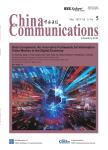Federated Edge Learning for the Wireless Physical Layer:Opportunities and Challenges
Federated Edge Learning for the Wireless Physical Layer:Opportunities and Challenges作者机构:National Mobile Communications Research Laboratory and Frontiers Science Center for Mobile Information Communication and SecuritySoutheast UniversityNanjing 210096China Purple Mountain LaboratoriesNanjing 211111China
出 版 物:《China Communications》 (中国通信(英文版))
年 卷 期:2022年第19卷第8期
页 面:15-30页
核心收录:
学科分类:0810[工学-信息与通信工程] 08[工学] 081104[工学-模式识别与智能系统] 0804[工学-仪器科学与技术] 080402[工学-测试计量技术及仪器] 0811[工学-控制科学与工程]
基 金:supported by the National Natural Science Foundation of China (NSFC) under Grants 61941104,61921004 the Key Research and Development Program of Shandong Province under Grant 2020CXGC010108 the Fundamental Research Funds for the Central Universities 2242022k30005 supported in part by the Research Fund of the National Mobile Communications Research Laboratory,Southeast University。
主 题:deep learning federated edge learning wireless communication physical layer
摘 要:Deep learning(DL)has been applied to the physical layer of wireless communication systems,which directly extracts environment knowledge from data and outperforms conventional methods either in accuracy or computation complexity.However,most related research works employ centralized training that inevitably involves collecting training data from edge devices.The data uploading process usually results in excessive communication overhead and privacy disclosure.Alternatively,a distributed learning approach named federated edge learning(FEEL)is introduced to physical layer designs.In FEEL,all devices collaborate to train a global model only by exchanging parameters with a nearby access point.Because all datasets are kept local,data privacy is better protected and data transmission overhead can be reduced.This paper reviews the studies on applying FEEL to the wireless physical layer including channel state information acquisition,transmitter,and receiver design,which represent a paradigm shift of the DL-based physical layer design.In the meantime they also reveal several limitations inherent in FEEL,particularly when applied to the wireless physical layer,thus motivating further research efforts in the field.



